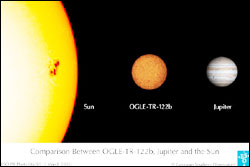Students from Duke University’s Pratt School of Engineering are partnering with Carnegie Mellon University’s “Red Team” in an effort to win a $2 million prize from the Defense Advanced Research Projects Agency (DARPA). All they have to do is complete the toughest ground course ever devised for a self-guided robotic vehicle.
The contest, called the DARPA Grand Challenge, is a race between fully self-guided ground vehicles to be conducted in the Southwestern United States on Oct. 8,
Livermore scientists are working to solve a 50-year-old question: Can neutrinos – a particle that is relatively massless, has no electric charge yet is fundamental to the make-up of the universe – transform from one type to another?
Scientists are using two giant detectors, one at Fermi Lab and another in a historic iron mine in northern Minnesota, to work on the answer.
As part of the international team working on the Main Injector Neutrino Oscillation Search (MINOS) proj

Very Large Telescope Finds Planet-Sized Transiting Star
An international team of astronomers have accurately determined the radius and mass of the smallest core-burning star known until now.
The observations were performed in March 2004 with the FLAMES multi-fibre spectrograph on the 8.2-m VLT Kueyen telescope at the ESO Paranal Observatory (Chile). They are part of a large programme aimed at measuring accurate radial velocities for sixty stars for which a temporary br
The human brain is like a general in a bunker. Floating in its bubble of cerebrospinal fluid, it has no direct window to the outside world, so the only way for the brain to observe, comprehend, and order the body into action is to rely on information it receives. This information comes to it through a sophisticated system of sensory neurons that connect the brain to organs like the eye, ear, nose, and mouth.
In recent years, biologists and neuroscientists have been trying
Mayo Clinic researchers have discovered a genetic marker that may pave the way for a fast, inexpensive blood test to predict one type of deadly stroke that strikes 30,000 people in the United States annually.
The article and an editorial appear in the March edition of the Journal of Neurosurgery, http://www.thejns-net.org/jns/issues/toc_pre.html. The Mayo Clinic researchers report that people with key variations in a gene that affects the ability of blood vessels to relax are 10 ti
Weizmann Institute findings might advance search for new therapies for injured nerve fibers
Long distance messengers star in many heroic tales, perhaps the most famous being the one about the runner who carried the news about the victory of the Greeks over the Persians in the fateful battle of Marathon. A team of researchers at the Weizmann Institute of Science has now discovered how molecular messengers perform a crucial role in the ability of injured nerve cells to heal them